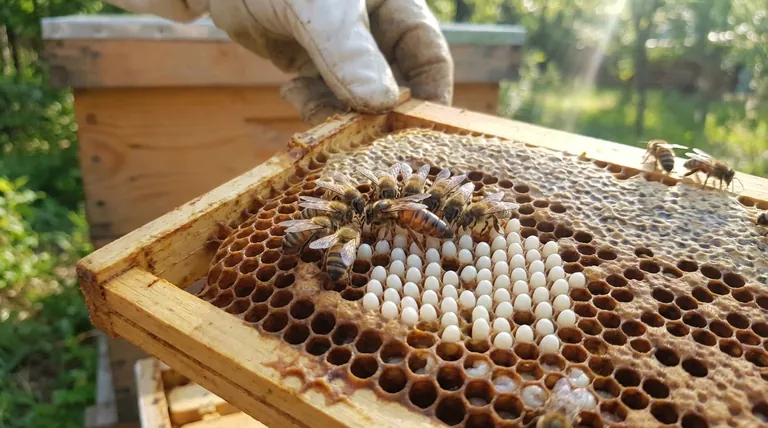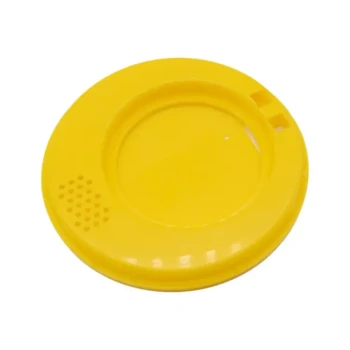The presence of eggs in a honey bee colony is the single most important indicator of its current health and status. It confirms that a queen was not only present but actively laying within the last three days, as a bee egg only remains in that stage for 72 hours before hatching into a larva.
Finding eggs is the gold standard for confirming your colony is "queenright." It provides more definitive, real-time information about the hive's viability than even a direct visual sighting of the queen herself.

The Significance of Eggs in a Hive Inspection
A beekeeper's primary goal during an inspection is to assess the health of the colony as a superorganism. The presence and pattern of brood—eggs, larvae, and pupae—tell the most important part of that story.
The 3-Day Confirmation Window
An egg is only an egg for three days. Seeing them, especially standing on end at the bottom of a cell, means you are looking at the queen's work from today, yesterday, or the day before. This is the most recent data you can get on her status.
A Reliable Proxy for the Queen
Finding the queen can be a difficult and time-consuming task. She is only one bee among tens of thousands, and searching for her can disrupt the colony unnecessarily. The evidence of her work—the eggs—is a much more efficient and reliable confirmation that she is alive and performing her duties.
What a Healthy Brood Pattern Reveals
The quality and pattern of the eggs are just as important as their presence. A healthy, well-mated queen lays in a specific, methodical way that signals a strong and productive colony.
One Egg Per Cell
A productive queen carefully lays a single egg in the bottom-center of each worker cell. She is precise and consistent in her placement.
A Tight, Concentric Pattern
The queen will typically lay in a dense, solid pattern, often radiating out from the center of a frame. You should see a large, contiguous patch of cells filled with brood of a similar age. This "brood pattern" shows she is fertile and efficient.
Understanding Problematic Signs
Deviations from a healthy brood pattern are critical warning signs that the colony is in distress. These are indicators that require immediate investigation.
Multiple Eggs Per Cell
Finding two, three, or more eggs in a single cell, often laid haphazardly on the cell walls, is a classic sign of laying workers. When a colony has been queenless for an extended period, the ovaries of some worker bees activate. However, they are not mated and can only lay unfertilized (drone) eggs, indicating a failing hive.
A Spotty or "Shotgun" Pattern
A brood pattern with many empty cells scattered among capped brood is called a shotgun pattern. This can signal an aging or poorly mated queen who is running out of sperm, or it could be an indicator of brood diseases where larvae are being removed by nurse bees.
No Eggs, Only Older Brood
If you find capped brood or larvae but no eggs, it means your queen was active more than three days ago, but she may now be missing or has stopped laying. This is a critical situation, as the colony has a limited window to raise a new queen from the youngest remaining larvae.
Making the Right Decision for Your Colony
Your observations of the brood frame should directly guide your next actions as a beekeeper.
- If your primary focus is confirmation of a healthy hive: Look for single eggs centered in cells within a tight, solid brood pattern. If you see this, your work is done; close the hive with confidence.
- If you suspect the colony might be queenless: The absence of eggs is your first major clue. If you also see no young larvae, the colony is in urgent need of a new queen.
- If you see signs of laying workers (multiple eggs per cell): This is a serious condition that must be addressed immediately, often by combining the hive with a strong, queenright colony.
Ultimately, learning to read the brood is the most fundamental skill for understanding the true health and future of your honey bee colony.
Summary Table:
| Observation | Indicates | Action |
|---|---|---|
| Single eggs in a tight pattern | Healthy, laying queen | Hive is queenright; close up. |
| Multiple eggs per cell | Laying workers; failing hive | Requires immediate intervention. |
| Spotty, 'shotgun' brood pattern | Aging queen or disease | Investigate queen quality and health. |
| No eggs, only older brood | Queen missing or failing | Colony needs a new queen urgently. |
Ensure the health and productivity of your apiaries with reliable equipment from HONESTBEE.
For commercial apiaries and beekeeping equipment distributors, consistent hive health is the foundation of success. Our wholesale-focused operations provide the durable supplies and equipment you need to efficiently manage your colonies and make confident, data-driven decisions.
Contact our wholesale team today to discuss your specific needs and secure the tools for a thriving operation.
Visual Guide

Related Products
- Jenter Queen Rearing Kit Complete Set for Bee Breeding
- No Grafting Queen Rearing Kit: System for Royal Jelly Production and Queen Rearing
- Premium Wood Framed Metal Wire Queen Bee Excluder
- High Performance Plastic Queen Excluder for Beekeeping and Apiary Management
- Professional Galvanized Hive Strap with Secure Locking Buckle for Beekeeping
People Also Ask
- What is queen rearing in beekeeping? Take Control of Your Apiary's Genetics
- Why is raising queens beneficial for beekeepers? Gain Control Over Genetics and Costs
- What happens to the colony population during the 5–6 weeks after a new queen emerges? Understand the Natural Dip and Rebound
- How long does it take for a new queen to emerge, mate, and lay eggs? A Beekeeper's 10-14 Day Guide
- What are the implications of delayed oviposition in queen bees? A Strategy for Superior Queen Quality



















